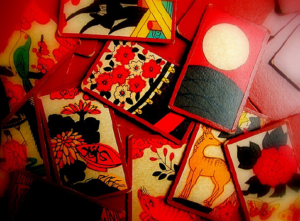In the 18th year of Tenmon (A.D. 1549) when Francisco Xavier landed in Japan from Europe the crew of his ship had carried a set of Hombre, 48-card Portuguese playing cards, which became extremely popular with the Japanese. Through a colorful history of being banned and declared illegal (which did not diminish cardplaying and gambling by the populace) the game of Hanafuda, which combined traditional Japanese games with Western-style playing cards, was developed in the late 1800s.
Entertaining and highly addictive the Hanafuda cards contain no numbers. Instead the 48 cards in the deck use pictures of flowers and plants. The deck is organized into 12 suites, one for each month of the year, and the types of plants represent the months in which they bloom. Hanafuda is commonly played in Hawaii and South Korea, though under different names. In Hawaii it is called Sakura, Hanafura, and Higobana.
Just ask any local or longtime resident about this card game and you will likely invoke wonderful memories of fun that could go on for hours, and hours, and hours.
The colorful ‘flower cards’ are thicker than Westernstyle cards and players enjoy the “smacking” sound they make when slapped together.

